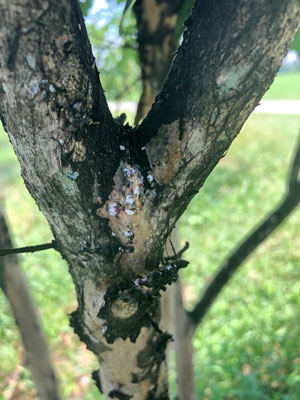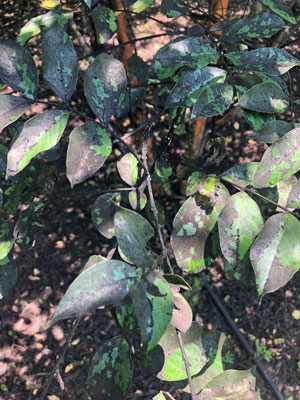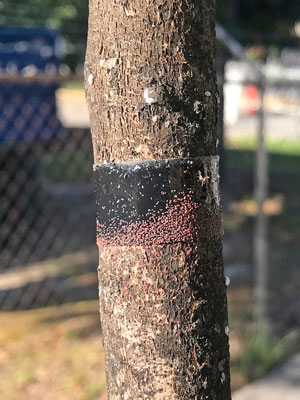8/1/2022
Managing Crapemyrtle Bark Scale in Nurseries
Juang Horng “JC” Chong

When I think about a southern landscape, crapemyrtle is the first plant that comes to my mind. The popular ornamental trees and shrubs are as permeating as the humidity in the summer. Crapemyrtles are one of the most economically important tree species to the nurseries and the landscapes of the southern United States. According to USDA Census of Horticulture in 2019, more than 18% of deciduous flowering trees sold in the United States are crapemyrtles, earning an estimated value of $69.5 million.
It’s understandable that great concerns were raised when crapemyrtle bark scale (CMBS) was first detected near Dallas, Texas, in 2004. CMBS is now found in communities in Alabama, Arkansas, Delaware, Georgia, Florida, Kansas, Kentucky, Louisiana, Maryland, Mississippi, Missouri, New Mexico, North Carolina, Oklahoma, Pennsylvania, South Carolina, Tennessee, Texas, Virginia and Washington, D.C. Its continuous spread across the range of crapemyrtles (particularly in Plant Hardiness Zone 6 or higher) in the United States is expected.
Pictured: Crapemyrtle bark scales often hide under loose bark. When they’re crushed, the bodies exude red fluid.
Infestation by CMBS, which is a sucking insect, removes large amounts of moisture and nutrients. The infestation slowly weakens crapemyrtle trees over time, and the infested trees have reduced growth and smaller and fewer flower clusters. The large amount of honeydew and black sooty mold, which can develop on leaves and trunks, and all surfaces under the crapemyrtle trees, can be quite objectionable.
Although more than 20 plant species have been identified as hosts of CMBS in other countries and in greenhouse experiments, observations of CMBS infestations in the landscape in the United States have only been reported on crapemyrtle, American beautyberry, St. Johnswort and spirea. Crapemyrtles remain the major concern and target for management because CMBS appears to prefer and grow best on crapemyrtles.
CMBS infestation increases the maintenance and pest management costs on crapemyrtles, which have traditionally been low maintenance. I’ve seen the damage of this pest firsthand. A crapemyrtle specialist grower in South Carolina estimated that he will lose about $138,000 if he culls all heavily infested trees in one block in the nursery. This estimate of damage doesn’t include insecticide and labor costs needed to treat the lightly or moderately infested trees.
Identification & control
Infestation by CMBS isn’t difficult to diagnose. One of the most obvious signs of infestation is the presence of sooty mold. Plants with sooty mold should be inspected carefully to determine if the sooty mold was caused by crapemyrtle aphid or CMBS. CMBS is the only felt-scale species that feeds on crapemyrtles. The reddish to purplish bodies of females are covered by white, loosely woven, cottony wax sacs, which are about 2 mm (or 8/100 in.) long. Immature females don’t have the waxy sacs and, therefore, their hairy and pink bodies are exposed. An infested stem may “bleed red” when rubbing fingers over the scale insects and crushing them.
 Pictured: Crapemyrtle bark scale infestation is associated with a large amount of black sooty mold covering all plant surfaces and surfaces under the plants.
Pictured: Crapemyrtle bark scale infestation is associated with a large amount of black sooty mold covering all plant surfaces and surfaces under the plants.
The best approach to CMBS management is to prevent infestations in the first place. Many incidences of infestations in landscapes and nurseries originate from transplanting infested plants. Once inside the nursery, moving infested plants from one area to another will spread the infestation. To prevent introduction, examine all plants and reject or treat the infested plants before transplanting. If the infestation is only limited to a small group of plants, I encourage growers to destroy heavily infested plants because it may be more economical to destroy than to treat. Reputational damage also can be more costly than the culled trees. The culled materials should be burned or buried to avoid spread in the nursery.
Ladybeetle larvae, particularly those of the Hyperaspis species, are often found on infested crapemyrtle trees, feeding on the CMBS. As many as 10 species of ladybeetle and lacewing species have been identified in Texas, providing up to 75% suppression of CMBS population in some years. There are currently no biological control agents available for purchase and release against CMBS. Releasing mass-produced ladybeetle species is not likely to be successful. Instead, growers and landscape care professionals interested in biological control should avoid using broad-spectrum insecticides, such as carbamates (carbaryl), organophosphates (such as acephate) and pyrethroids (such as bifenthrin). Foliar application of neonicotinoids should also be avoided (but see below for recommendations on drench applications). These insecticides reduce natural enemy populations and exacerbate CMBS infestation.
Growers and plant managers can apply insecticides in two ways: first, they can apply imidacloprid or dinotefuran as a soil drench once per year in the spring when the crapemyrtles break buds. Soil drench application of neonicotinoids have been shown to minimize the negative impacts of neonicotinoid application on natural enemies in other systems. For growers who cannot or choose not to use neonicotinoids, the alternatives are flupyradifurone (Altus) or spirotetramat (Kontos). Some of these products allow for basal trunk application, which can save on application volume, time and labor. (Read product labels for more information.)
Alternatively, growers and plant managers can spray insecticides (bifenthrin, dinotefuran, imidacloprid, flupyradifurone, pyriproxyfen, buprofezin or cyantraniliprole) to the trunks and stems of infested trees when the CMBS population is producing crawlers (or hatchlings). I recommend making two applications (the second application scheduled 10 to 14 days after the first) for each generation. CMBS has two to three generations per year, with applications against the first two generations being the most important.
 Pictured: Crawler emergence can be monitored with sticky tape wrapped around the trunk of an infested tree.
Pictured: Crawler emergence can be monitored with sticky tape wrapped around the trunk of an infested tree.
The crawler emergence time is not known for all states. In Texas and Louisiana, most of the crawlers emerge in mid-April to mid-May (first generation) and late September to mid-October (second generation). The timing of crawler emergence changes from place to place and from year to year because of varying temperatures. The best way to know precisely when the crawlers are emerging in your area is to trap them with sticky tape. This can be easily done by wrapping black electrical tape (sticky side facing out) around an infested trunk in April and in August. Check the tape weekly and start spraying when you find purple crawlers stuck to the tape.
It’s important to achieve good spray coverage on the trunks and stems because CMBS is often found hidden on branch crotches, bud scales, scars, crevices or under shedded bark. A higher spray volume and the addition of a surfactant (such as a spreader-sticker) in the spray solution will be needed. No insecticide treatment is completely effective with one application. Repeated applications over multiple seasons or years may be needed to completely suppression the CMBS population.
Some crapemyrtle cultivars (such as Natchez) are highly attractive to bees and other pollinators. Cultivars that produce a greater number of flower clusters and flowers are generally more attractive to bees. Studies have demonstrated that soil drench applications of neonicotinoids in the spring (after bud break, but before bloom) resulted in the lowest concentration of insecticide residue in the pollen of crapemyrtles. Therefore, the best application timing is the spring for growers and managers interested in applying neonicotinoids as a soil drench. For those concerned with any level of impact on pollinators, management of CMBS infestation should focus on spraying the trunk and stems. GT
JC Chong is a Professor and Extension Specialist in Turf and Ornamental Crop Entomology at Clemson University, and editor of the PestTalks e-newsletter.